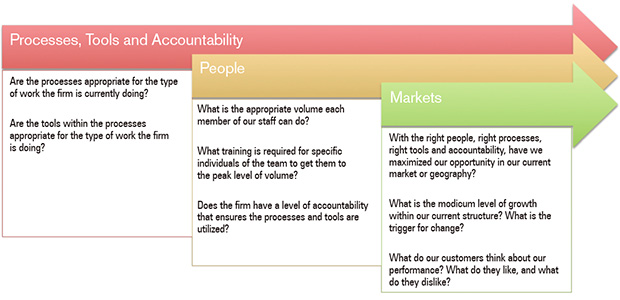
Many industries have a certain capacity that dictates the quantity of people they will serve at any given time. Imagine an airline that does not have additional seats on its plane but chooses to accept a family of four on a flight from New York to Los Angeles. The parents stand in the back while the children take turns sitting in the lavatory. Or consider your favorite restaurant. In their zeal to seat one more patron, they pop up a folding table in the corner of the restaurant. However, because the restaurant has a finite number of servers and bus staff, it takes two or three times as long to serve the additional patron. The quality of service to other patrons also declines. With too many hectic nights like that, this favorite restaurant might lose its preferred status.
Construction companies often operate under a different premise. The thought of turning away work after the recent famine the industry has experienced almost seems illogical. However, times are rapidly changing, and contractors of all types are quickly becoming flush with work. Countless contractors have seen their annual volumes balloon in recent months, and, like stranded castaways on a deserted island scrambling for every morsel of food, contractors are gobbling backlog—in some cases with no semblance of a plan for how they will manage the work.
Contractors often try to justify the projects that they should have said “no” to long after the bills are tallied and losses are accounted—or unaccounted—for. No one has a crystal ball or tarot cards divining senior management on the correct number of projects, sufficient volume level or the appropriate risk level. A contractor’s saturation point is often an afterthought, causing him or her to ask, “Who are we going to get to run this?” shortly after a bid or proposal is accepted.
Five or six years ago, “no” was not in a contractor’s vocabulary primarily because opportunities were few and far between. The economy has improved but at such a sluggish rate that some decision makers still face trepidation in regard to the state of the industry. However, gobbling up work as if there will be no tomorrow is not the correct answer. Many strategists quickly point to the added risk of additional volume and profitability with little control. Contractors should pause, reflect on the basics—the firm’s core values and vision—and remember that the customer should remain a top priority.

When to Say No
Whether Disney or Wal-Mart, an overwhelming number of businesses include some mention of their customers as part of their core values and overarching vision. Construction firms are no different. At their core, most businesses recognize that they exist at the sole discretion of their employees and customers. Everyone has options. However, as firms add volume at an uncontrolled rate, they often give little thought to the customer experience. Put another way, will the management and supervisory team be able to provide the highest quality of customer service or at least the minimum level of service as prescribed by the tenets of the firm’s mission, vision and values? One could argue that there is little loyalty in the construction business: “Our customers are only loyal as long as we are low.” Consider an alternate argument. If the firm executed projects according to the strictest adherence to its core values, would loyalty be stronger? For example, if a patron went to the classiest restaurant in town only to receive mediocre service provided by the server-in-training, how long would this restaurant be considered one of the best?
The current trend appears to be geared toward volume obsession, with little regard for planning and personnel. Unfortunately, contractors have also failed to maintain a healthy staffing level, relying on overworked and often underequipped managers, engineers, assistants and superintendents. As the work comes in, new projects are often assigned to the greenest junior associate, the individual with the least knowledge and experience. The delicate tightrope walk of overhead management in relation to volume is a precarious journey and one that hardly has a predictive quality. However, as firms continue to see prosperity, they should have a stronger commitment to core values and the firm’s overall ability to provide quality service and a quality finished product. When determining when to say no to a project, most best-of-class firms have a “go or no-go” process that weighs some of the following criteria.
- Knowledge of the customer:
- Does this customer align with our firm’s core values?
- Does this customer conform to our ethical standards?
- Firm’s ability to commit:
- Do we have the office management to serve this customer?
- Do we have the field resources to serve this customer?
- Short- and long-term views:
- Does this customer have future opportunities?
- Does this customer have future service opportunities (particularly for an electrical or mechanical contractor)?
- Location/niche:
- Is this customer within our core geographical or niche market?
- If this customer is outside our geographical or niche market, what is the compelling reason we should pursue the project?
Every firm’s “go or no-go” criteria should be customized according to its core values. As described in the first bullet, alignment is paramount. Firms often create a series of plastic values and mission statements that adorn a conference room or website but fail to operate how senior management envisions it should.
Strategic Growth Plan
In a similar fashion, many firms have created a flexible vision for the firm. For example, a firm establishes a growth goal of $50 million in revenue. As it reaches the $50 million mark, it quickly revises the goal to $60 million, then $70 million. Unfortunately, the goals of creating infrastructure to support that volume goal do not follow in lockstep, resulting in a $70 million firm operating with a $40-50 million infrastructure. This is not to say a firm should not grow. However, every firm needs a coordinated plan for volume growth that provides appropriate growth in commensurate areas of the business. A restaurant that wants to add customers makes a strategic investment in adding kitchen space, dining areas, etc. Additionally, it measures the anticipated gains of a capital expenditure. Put another way, will the new space provide additional profit in the long term? How often does a contractor double its annual revenue, only to make the same profit as it did when it was half its size? Once again, growth is not a bad thing. However, pursuing growth simply because it is the bright, shiny object on the horizon adds unacceptable levels of risk that might compromise the health of the firm and the integrity of the firm’s core values and vision.
If growth is an important element of the firm’s strategic plan, the firm’s leadership must consider alternate elements to the strategic plan in a proactive nature. For example, see Figure 1 (below).
 Figure 1. Questions About Your Strategy
Figure 1. Questions About Your StrategyThe main tenet of Figure 1 is to ask probative questions about the infrastructure of one’s firm. Many visionary leaders seek answers outside their firms and believe their obsession with volume will solve problems. But with the right infrastructure and level of people adhering to the plan, a firm can then target the appropriate volume and customers. Of course, this premise requires discipline, and it is a shift from the “get the work and they will come” mentality to a “build the company and the work will come” mantra. The final question posed in Figure 1 examines the perception of the customer: “How are we doing?” Harkening back to the days of Ed Koch, the former mayor of New York City, firms must recognize the ramifications of their actions and use the customers as the ultimate barometer. Senior management should continually ask themselves more about how they are performing today and less about markets in which they feel they are underrepresented. Assuming the firm is chasing the right customers and that they are in alignment with the firm’s master plan, super-serving those customers should be everyone’s priority.
The Right Choice
No one likes to hear that the restaurant of their choice has no room for him or her. However, that feeling of rejection bears no comparison to that of making an investment in a meal that comes with cold food and deplorable service that makes you feel like a second-class customer. For a contractor, turning away work comes with little consolation. Who relishes that awkward moment of telling a customer that you would be doing them a disservice if you took the work and stumbled because you do not have the capacity, capabilities, staff, etc. to do the work effectively and to the standard that customers would expect? For those who see this as a difficult conversation, consider the alternative. Envision trying to explain cost overruns, missed deadlines, accidents, rework, etc. at the end of a disastrous project. That customer would then tell others about their horrible experience. Rarely do people comment on being turned away, but it is a safe bet that they will provide copious amounts of feedback on a negative experience. As the economy continues to improve, contractors must maintain their discipline and focus when determining the right level of volume and backlog to successfully maintain and grow their businesses. Customer care is imperative for everyone and every business. Contractors need to learn the art of turning away patrons with dignity rather than saying yes and underserving them.
